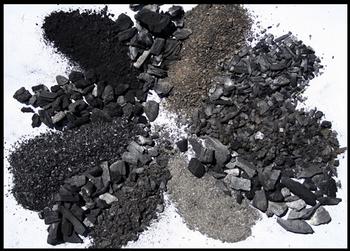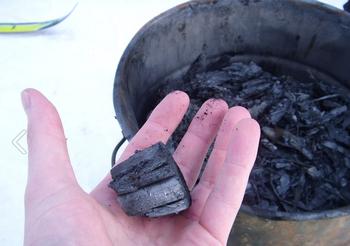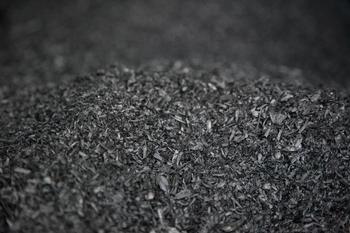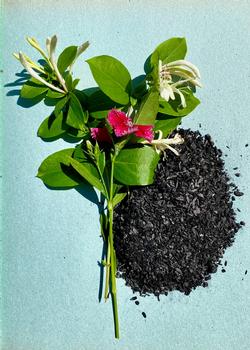Is biochar right for your garden? The answer is complicated.
-
Barbara Robertson
-
You might not think of burying charcoal briquettes in your garden, and you definitely should not do that. But you might consider adding biochar, the briquette’s cousin, to your soil.
 Biochar can be large chunks of charcoal or fine powder. Try to find small, fine-textured, porous flakes. Photo: Sanjai Parikh
Biochar can be large chunks of charcoal or fine powder. Try to find small, fine-textured, porous flakes. Photo: Sanjai ParikhBiochar is a fine-grained, highly porous soil additive. It looks like charcoal because it’s manufactured with same method used to create the lumps of carbon called briquettes.
However, biochar is made for agricultural purposes from plants such as grass, agricultural and forest residues. Charcoal briquettes are made for grilling, and might contain additives and chemicals toxic to plants.
To produce biochar, manufacturers slowly cook organic material (biomass) in a low-oxygen environment using a process called pyrolysis that converts carbon in the biomass into a solid, stable form. (Byproducts are recycled to fuel the combustion.) The resulting biochar is typically 70 to 80 percent carbon.
When biochar is buried in soil, most of its carbon stays trapped and out of the atmosphere for decades, even centuries if given the right conditions. Biochar is made from plant material slowly cooked at high temperature in a low oxygen environment. When buried in soil, it sequesters carbon. K. Salo
Biochar is made from plant material slowly cooked at high temperature in a low oxygen environment. When buried in soil, it sequesters carbon. K. SaloIn addition to soil-sequestered carbon’s role in fighting climate change, carbon is an essential part of healthy soil. In plants, roots exude carbon into soil in the form of sugars that attract and feed beneficial micro-organisms, and the micro-organisms, in turn, provide nutrients to plants. Because intensive agricultural cultivation has resulted in carbon loss in soil, scientists are also evaluating biochar’s potential role in soil restoration.
Biochar is porous, with tiny chambers that can absorb and retain water and nutrients and provide a habitat for beneficial microorganisms. The surfaces bind toxic heavy metals thus preventing the uptake to plants. Biochar’s high pH neutralizes acidic soil.
But, not all biochar is identical. Tiny chambers in the porous biochar can absorb and retain water and nutrients and provide habitat for beneficial micro-organisms. Oregon Forestry Dept
Tiny chambers in the porous biochar can absorb and retain water and nutrients and provide habitat for beneficial micro-organisms. Oregon Forestry DeptSometimes biochar spurs microbial activity, and some biochars reduce microbial activity.
Biochar’s effectiveness depends on the organic matter used to make it, the process, the soil type to which it’s applied, and amount and manner of application. The range of temperatures and cooking times will produce chemically and physically different biochar types. A biochar made from straw is different from one made from coconut husks.
Thus, the few studies on biochar in home gardens have produced mixed results. A Michigan State University scientific agricultural study summarized 16 experiments that found biochar, on average, increased crop yield by 10%. But other researchers tested a soil mix with biochar and found little effect on the yield and quality of cucumber, tomato, Swiss chard, basil, lettuce and snapdragons. Master Gardeners led by Iowa State University’ researchers, applied biochar directly to soil without adding compost or other amendments and found mixed results after three years.
In sum, Washington State University Extension lists good uses of biochar as improving aeration in heavy or compacted soil, increasing soil aggregation in fine-textured soil, and improving sandy soil’s water-holding capacity. Further, all soil types can benefit from enhanced fungal biodiversity, increased availability of plant nutrients, and increased plant drought and disease resistance when used appropriately. Biochar can neutralize highly acidic soil. Photo: Barbara Robertson
Biochar can neutralize highly acidic soil. Photo: Barbara RobertsonIf you decide to try biochar, look for fine-textured porous particles made from good quality materials slow cooked at extremely high (300 to 500 degree C) temperatures. Keep biochar in an airtight container in a cool, dry place away from ignition sources. Wear a dust mask if you need to crush it. Start by adding small amounts and observe the results. Biochar will likely increase soil alkalinity, which could injure acid-loving plants and earthworms.
Some recommend “charging” biochar by mixing it 50-50 with compost. Water the mix to a thick soup consistency and let it soak for two weeks. (Moist compost also greatly suppresses any flammability.) Turn it into soil much like you’d turn a cover crop.
Will biochar help you mitigate climate change, build your soil, and help your plants survive the drought? It’s uncertain, but in any case, you are in safe territory with biochar. You have nothing to lose by trying it, and everything to gain if it works.
For more information, visit the UC Marin Master Gardener website: http://marinmg.ucanr.edu.




